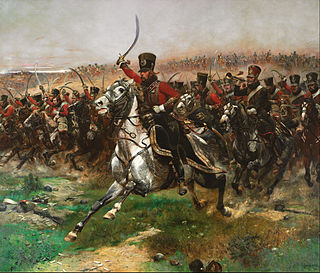 W
WA casquette d'Afrique was a type of lightweight military headgear generally used by the French metropolitan and colonial armies from the early 1830s to the 1860s.
 W
WHistorically, cavalry are soldiers or warriors who fight mounted on horseback. Cavalry were the most mobile of the combat arms, operating as light cavalry in the roles of reconnaissance, screening, and skirmishing in many armies, or as heavy cavalry for decisive shock attacks in other armies. An individual soldier in the cavalry is known by a number of designations depending on era and tactics, such as cavalryman, horseman, trooper, cataphract, knight, hussar, uhlan, mamluk, cuirassier, lancer, dragoon, or horse archer. The designation of cavalry was not usually given to any military forces that used other animals for mounts, such as camels or elephants. Infantry who moved on horseback, but dismounted to fight on foot, were known in the early 17th to the early 18th century as dragoons, a class of mounted infantry which in most armies later evolved into standard cavalry while retaining their historic designation.
 W
WChasseur, a French term for "hunter", is the designation given to certain regiments of French and Belgian light infantry or light cavalry to denote troops trained for rapid action.
 W
WThe Hardee hat, also known as the Model 1858 Dress Hat and sometimes nicknamed the "Jeff Davis", was the regulation dress hat for enlisted men in the Union Army during the American Civil War. The Hardee hat was also worn by Confederate soldiers. However, most soldiers found the black felt hat to be too hot and heavy and shunned its use, preferring a forage cap or slouch hat. However, the unadorned, plain and often field-modified Hardee hat was worn by Union troops, especially in the Western theater. The hardee hat was most famously worn, and easily identified, as the hat worn by the Union Army's Iron Brigade, which became their trademark and were popularly known, by the nickname, "The Black Hats".
 W
WThe kepi is a cap with a flat circular top and a peak, or visor. In English, the term is a loanword of French: képi, itself a re-spelled version of the Alemannic German: Käppi, a diminutive form of Kappe, meaning "cap". In Europe, this headgear is most commonly associated with French military and police uniforms, though versions of it were widely worn by other armies during the late 19th and early 20th centuries. In North America, it is usually associated with the American Civil War, as it was worn by soldiers on both sides of the conflict.
 W
WThe McClellan saddle was a riding saddle designed by George B. McClellan, after his tour of Europe as the member of a military commission charged with studying the latest developments in engineer and cavalry forces including field equipment. Based on his observations, McClellan proposed a design that was adopted by the Army in 1859. The McClellan saddle was a success and continued in use in various forms until the US Army's last horse cavalry and horse artillery was dismounted late in World War II. Today, the McClellan saddle is used by ceremonial mounted units in the US Army. The saddle was used by several other nations, including Rhodesia and Mexico, and to a degree by the British in the Boer War. The saddle came in various seat sizes that predominantly ranged from approximately 11 to 12 ½ inches.
 W
WA shako is a tall, cylindrical military cap, usually with a visor, and sometimes tapered at the top. It is usually adorned with some kind of ornamental plate or badge on the front, metallic or otherwise, and often has a feather, plume, or pompom attached at the top.
 W
WThe Sibley tent was invented by the American military officer Henry Hopkins Sibley and patented in 1856. Of conical design, it stands about 12 feet (3.7 m) high and 18 feet (5.5 m) in diameter. It can comfortably house about a dozen men.
 W
W"Skipper" is the name of the Virginia Tech Corps of Cadets' cannon that is sounded at home football games and other events. The game cannon was created by a group of cadets in 1963 for Virginia Tech football games and special events.
 W
WA slouch hat is a wide-brimmed felt or cloth hat most commonly worn as part of a military uniform, often, although not always, with a chinstrap. It has been worn by military personnel from many different nations including Australia, Ireland, the United Kingdom, Canada, India, New Zealand, Southern Rhodesia, France, the United States, the Confederate States, Germany and many others. Australia and New Zealand have had various models of slouch hat as standard issue headwear since the late Victorian period.
 W
WThe Zouaves were a class of light infantry regiments of the French Army serving between 1830 and 1962 and linked to French North Africa, as well as some units of other countries modelled upon them. The zouaves, along with the indigenous Tirailleurs Algeriens, were among the most decorated units of the French Army.